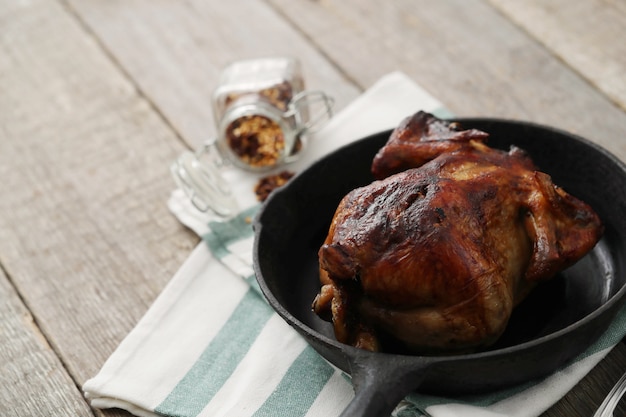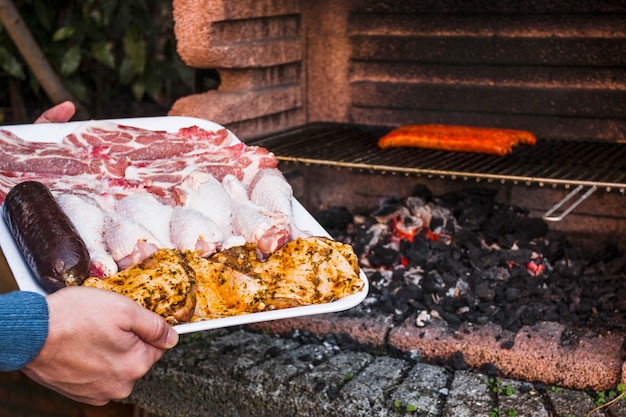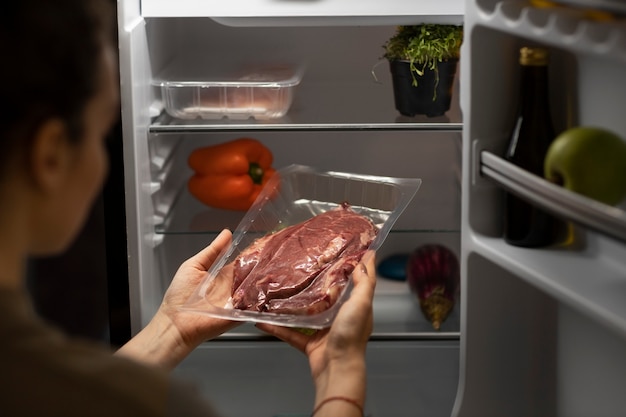As a seasoned home cook, I've always been fascinated by the art of cooking meat, especially pork. There's a certain magic to transforming a simple piece of pork into a succulent, flavourful masterpiece. But I've also learned that achieving juicy, tender pork requires more than just a sprinkle of salt and pepper. It's about understanding the science behind cooking, mastering the right techniques, and, most importantly, finding the perfect oven temperature.
Over the years, I've experimented with countless temperatures, cuts of pork, and cooking methods. There were times I ended up with dry, tough pork, a culinary disappointment that left me feeling like I'd failed. But those failures taught me valuable lessons – lessons that led me to discover the secret to consistently achieving juicy, melt-in-your-mouth pork.
Today, I want to share this knowledge with you. This guide will be more than just a list of temperatures. It's an invitation to embark on a culinary journey, to explore the science behind cooking pork, and to uncover the secrets of achieving juicy perfection every time. Ready to join me?
(Part 1) The Science of Cooking Pork: Unveiling the Secrets of Tenderness

Before diving into the details of oven temperatures, let's take a moment to understand the fundamental science behind cooking pork. This knowledge will provide a solid foundation for making informed decisions about our cooking process and, ultimately, achieving those delicious results we all crave.
1.1 The Protein Dance: How Heat Transforms Pork
Think of a piece of raw pork as a complex dance floor filled with protein molecules. When you introduce heat, these molecules begin to move, unfold, and bind together in new ways. This process is known as denaturation, and it's the key to transforming raw pork into the cooked, firm texture we enjoy.
But here's the catch: different types of protein molecules have different "dance partners". Some prefer a slow, gentle waltz, while others thrive on a fiery tango. Pork, with its varied proteins, requires a careful approach to ensure its molecules dance in harmony, resulting in tender, juicy meat.
1.2 The Importance of Temperature: Finding the Perfect Rhythm
The temperature at which you cook pork directly affects how those protein molecules dance. Too high a temperature, and those proteins become tightly bound, leading to a tough, dry texture. Too low a temperature, and the proteins don't bind properly, resulting in a mushy, unappetizing texture.
For pork, the ideal temperature range lies between 145°F (63°C) and 160°F (71°C). This sweet spot allows the proteins to bind just enough to create that firm, cooked texture while still retaining moisture and tenderness.
1.3 Time and Temperature: A Symphony of Flavor
Time and temperature work together, like a symphony, to create the perfect symphony of flavor. A lower temperature generally requires a longer cooking time, allowing for a more gradual and even transformation of the proteins. A higher temperature, however, means a faster cooking time, but it also carries the risk of overcooking and drying out the pork.
The trick is to find the right balance, allowing enough time for the proteins to dance perfectly while preventing excessive moisture loss. This is where our understanding of different pork cuts comes in.
(Part 2) A Pork Cut for Every Palate: Exploring the Diversity of Flavor

The type of pork cut you choose is crucial to the final outcome. Each cut has its unique texture, fat content, and ideal cooking method. Understanding these characteristics allows us to tailor our cooking approach and select the perfect oven temperature for the best results.
2.1 pork tenderloin: The Quick and Delicate Dance
The pork tenderloin is a lean and versatile cut, perfect for a quick and flavorful meal. It's a relatively small cut, making it ideal for weeknight dinners or smaller gatherings. Its delicate texture requires a gentle touch, and it's often roasted, grilled, or pan-fried.
2.2 pork loin roast: The Classic Symphony of Flavor
For a more substantial meal, the pork loin roast is a popular choice. It's typically roasted whole, making it perfect for larger gatherings or special occasions. Its combination of lean meat and a thin layer of fat results in a juicy and flavorful roast when cooked correctly.
2.3 pork shoulder roast: The Slow and Steady Transformation
Pork shoulder roast is a tougher, fattier cut that requires a different approach. It benefits from slow cooking at a low temperature, allowing the tougher proteins to break down and the fat to render, creating a melt-in-your-mouth texture. It's perfect for braising, slow cooking, or even pulling for sandwiches.
(Part 3) Setting the Stage: Choosing the Right Oven Temperature

Now, let's get to the heart of the matter - finding the perfect oven temperature for each type of pork cut. Remember, our goal is to achieve juicy, tender pork, and the oven temperature plays a pivotal role in this culinary dance.
3.1 The Goldilocks Principle: Finding the Just-Right Temperature
For roasting pork, the ideal temperature range is between 325°F (163°C) and 350°F (177°C). This temperature provides a balance between gentle heat for tenderizing the proteins and enough heat for browning the exterior, creating a crispy, flavorful crust.
However, for smaller cuts like pork tenderloin, a slightly higher temperature of 375°F (191°C) might be necessary to ensure a quick and juicy cook. This higher temperature allows for faster cooking while still preventing excessive drying.
3.2 A Culinary Guide: Matching the Cut with the Oven Temperature
To make things easier, here's a table summarizing the recommended oven temperatures for different pork cuts:
| Pork Cut | Recommended Oven Temperature (°F) | Recommended Oven Temperature (°C) |
|---|---|---|
| Pork Tenderloin | 375 | 191 |
| Pork Loin Roast | 325-350 | 163-177 |
| Pork Shoulder Roast | 300-325 | 149-163 |
Remember, these are just guidelines. You might need to adjust the temperature based on your oven's quirks, the size of your cut, and your desired level of doneness.
(Part 4) Mastering the Technique: Tips for Juicy Pork Success
Now that you've chosen your cut and set the stage with the right oven temperature, let's explore some techniques to maximize your chances of juicy pork success.
4.1 The Art of Basting: Keeping Moisture Locked In
Basting is a simple yet effective technique for keeping pork moist and flavorful. While the pork is roasting, use a basting brush to apply a mixture of butter, herbs, and seasonings. This helps to lock in moisture and infuse the meat with delicious aromas.
You can get creative with your basting mixtures, experimenting with different herbs, spices, and even fruit juices for added flavor.
4.2 The meat thermometer: Ensuring Safety and Perfection
A meat thermometer is an essential tool for any home cook, and it's especially crucial when dealing with pork. It's not just about food safety, but about ensuring the pork is cooked to your desired level of doneness.
Insert the thermometer into the thickest part of the pork, avoiding bone. The ideal internal temperature for pork is 145°F (63°C), ensuring it's safe to eat while still retaining its juiciness.
4.3 Resting: Letting the Juices Settle
Once the pork is cooked to the desired internal temperature, resist the urge to carve it immediately. Instead, let it rest for 10-15 minutes before slicing. This allows the juices to redistribute throughout the meat, resulting in a more tender and flavorful outcome.
(Part 5) Navigating the Culinary Crossroads: overcooked pork Solutions
Despite our best efforts, we all have moments where we overcook our pork. But before you toss that seemingly dry piece of meat in the trash, remember, overcooked pork can still be salvaged. It may not be as juicy as perfectly cooked pork, but it can still be delicious in the right dish.
5.1 Overcooked Pork: A Culinary Rescue Mission
Overcooked pork is drier than perfectly cooked pork, but it's still safe to eat. The trick is to use it in dishes where dryness is not a problem, such as in stir-fries, curries, or stews.
Think of it as a culinary challenge. The drier texture can add a unique bite and depth of flavor to certain dishes.
(Part 6) Transforming Overcooked Pork: A culinary adventure
Here are some creative ways to use overcooked pork to create delicious meals.
6.1 Shredded Pork Sandwiches: A Flavorful Embrace
Overcooked pork can be shredded and used for delicious sandwiches. Simply pull the meat apart and toss it in your favourite barbecue sauce. Serve on toasted buns with your favourite toppings like coleslaw, pickles, and onions.
6.2 Pork and Noodle Stir-Fry: A Fusion of Flavors
Dice the overcooked pork and add it to a stir-fry with your favourite vegetables and noodles. The meat will add flavour and texture to the dish, creating a satisfying and flavorful meal.
6.3 Pork Chili: A Hearty and Soulful comfort food
Overcooked pork can be a great addition to a hearty chili. Simply chop it into small pieces and add it to the pot along with your favourite chili ingredients. The pork will add a depth of flavour and richness to the chili.
(Part 7) Navigating the Culinary Labyrinth: Frequently Asked Questions
Let's address some frequently asked questions about cooking pork to ensure you have all the information you need for your next culinary adventure.
7.1 How Do I Know When Pork is Done?
The best way to determine when pork is done is to use a meat thermometer. Insert the thermometer into the thickest part of the pork, avoiding bone, and ensure the internal temperature reaches 145°F (63°C).
7.2 What if My Pork is Overcooked?
Overcooked pork can still be salvaged and used in a variety of dishes. You can shred it for sandwiches, dice it for stir-fries, or add it to chili. Don't let a slight overcook ruin your meal!
7.3 Can I Use a Different Cooking Method for Pork?
Yes, you can use other cooking methods for pork, such as grilling, pan-frying, or braising. The ideal oven temperature will vary depending on the chosen cooking method.
7.4 What are Some Tips for Keeping Pork Moist?
Basting the pork with a mixture of butter, herbs, and seasonings can help to keep it moist. Resting the pork for 10-15 minutes after cooking allows the juices to redistribute, resulting in a more tender and flavorful outcome.
7.5 What are Some Good Recipes for Pork?
There are countless delicious pork recipes out there. Some popular options include roasted pork tenderloin with apple sauce, pork loin roast with rosemary and garlic, and pulled pork sandwiches. Don't be afraid to experiment and find new favorites!
(Part 8) The Journey Continues: A Culinary Invitation
Cooking pork to juicy perfection is a journey, not a destination. It's a journey of discovery, experimentation, and constant learning. It's about embracing the science behind cooking, mastering techniques, and, most importantly, having fun in the kitchen.
So, go ahead, experiment with different cuts, temperatures, and cooking methods. Don't be afraid to make mistakes, because they are the stepping stones to culinary success. And most importantly, remember that the best part of cooking is sharing the delicious results with those you love. Happy cooking!
Everyone is watching

Prime Rib Roast Cooking Time Chart: Per Pound Guide
Cooking TipsPrime rib roast. Just the name conjures images of lavish dinners, crackling fires, and hearty laughter. It’s ...

How Long to Bake Potatoes in the Oven (Perfect Every Time)
Cooking TipsBaked potatoes are a staple in my kitchen. They're incredibly versatile, delicious, and surprisingly easy to m...

Perfect Rice Every Time: The Ultimate Guide to Cooking Rice
Cooking TipsAs a self-proclaimed foodie, I've always been a bit obsessed with rice. It's the foundation of countless cuisi...

The Ultimate Guide to Cooking Asparagus: Tips, Techniques, and Recipes
Cooking TipsAsparagus. The mere mention of this spring delicacy conjures up images of vibrant green spears, crisp and burs...

Ultimate Guide to Cooking the Perfect Thanksgiving Turkey
Cooking TipsThanksgiving. Just the word conjures up images of overflowing tables laden with delicious food, the scent of r...
